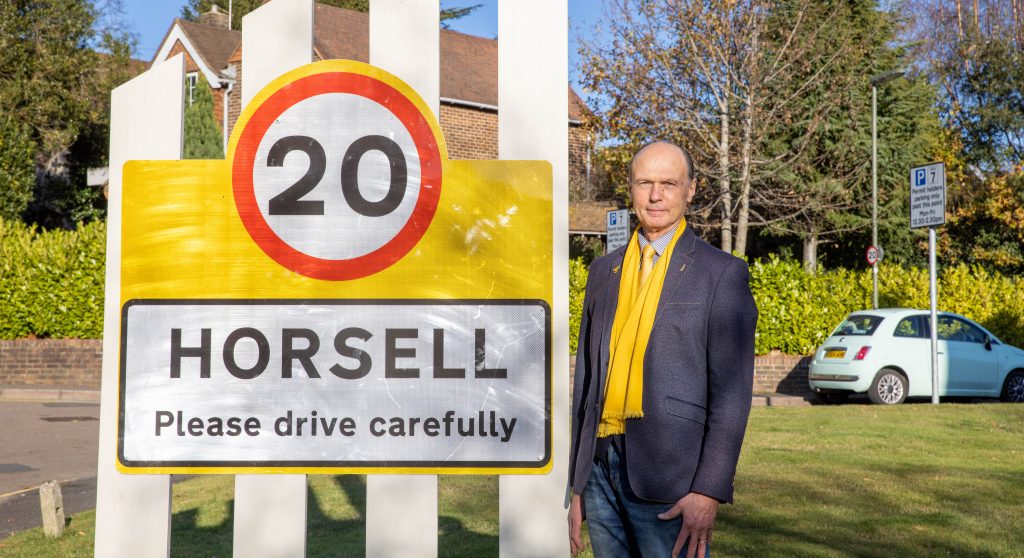 Abraham Lincoln
If given the truth, the people can be depended upon to meet any national crisis...
Abraham Lincoln
If given the truth, the people can be depended upon to meet any national crisis...
 Guildford news...
for Guildford people, brought to you by Guildford reporters - Guildford's own news service
Guildford news...
for Guildford people, brought to you by Guildford reporters - Guildford's own news service
County Council Says No to Making 20mph the New 30 with Signage Only
Published on: 19 Jan, 2022
Updated on: 19 Jan, 2022
By Julie Armstrong
local democracy reporter
A bid to make the default speed limit 20mph in all Surrey town centres and residential areas was thrown out by county councillors yesterday.
The Liberal Democrat councillor for Horsell pressed Surrey County Council in its meeting yesterday (January 18) to make 20mph the default speed limit in all residential areas and town centres where there is community support, and to do this simply by changing the 30 signs to 20.
Lance Spencer said this would reduce vehicle emissions and make people who choose to walk or cycle feel safer.
Surrey’s cabinet member for transport Matt Furniss (Con, Shalford) said this approach should be limited to roads where the existing average speed is a maximum of 24mph.
Any higher than this and there would need to be additional measures, he said, because signage on its own was not effective.
Opposition councillors argued his amendment amounted to the status quo – with Jonathan Essex (Green, Redhill East) saying it “should be ruled out of order” – because there wasn’t the money for traffic calming measures in all the places they wanted the speed reduced.
The council voted 46 for and 31 against Cllr Furniss’s amendment, scuppering Cllr Lance Spencer’s hopes.
Cllr Furniss announced the council would increase its road safety funding over the next three years, adding: “The desire for lower speeds has to be balanced against the need for reasonable journey times.”
Cllr Spencer (LD, Goldsworth East and Horsell Village) said: “I was probably a little naive in my hope that this motion would get cross-party support.
“My grandson will be 11 years old in 2030. He might rightly ask the question what was I doing back in 2022 when we knew how much impact we were all having on the climate, and why we’d not done more.”
He said New Year’s Day was the hottest on record with 16.2C recorded at St James’s Park and the seven hottest years on record were all in the last seven years.
Surrey was “quite unusual” in the high proportion of its carbon emissions coming from transport, he told council.
“Why? Because we have more roads, we have more cars per head of population, we have bigger cars and we have more wealth in Surrey to pay for the fuel.”
He argued most current requests for a 20mph zone were unviable because of the cost of traffic calming measures, and they should do away with these and just rely on signs.
In Horsell it would be “well in excess of £100,000… which means I’m never going to get it through the joint committee,” he said.
But Cllr Furniss argued signs alone were not effective, often only bringing about a reduction of 2mph.
He said Surrey Police did not support a 20mph limit “as they are not generally self-enforcing” and it would be an “unreasonable additional demand on their resources”.
He said if a speed limit was set too low and ignored, it would “criminalise the majority of drivers” and “bring the speed limit system into disrepute”.
He added that since 2014 Surrey has introduced 93 formal 20mph zones.
Cllr Liz Townsend (LD, Cranleigh & Ewhurst) said roads were much busier than in 1934 when “the 30mph limit was introduced”, while Nick Harrison (Res Assoc, Nork & Tattenhams) said a child is “three times more likely to die if hit in a 30mph vehicle collision compared to 20mph”.
Cllr John O’Reilly (Con, Hersham) said: “My concern is, where the natural speed is 30, or maybe 33, arbitrarily reducing it to 20mph without other traffic calming measures may give an illusory sense of security, particularly for pedestrians.”
Responses to County Council Says No to Making 20mph the New 30 with Signage Only
Leave a Comment Cancel replyPlease see our comments policy. All comments are moderated and may take time to appear.
Recent Articles
- Guildford Institute’s Crowdfunding Project for Accessible Toilet in its New Community and Wellbeing Centre
- Letter: Guildford – Another Opportunity Missed?
- Letter: GBC’s Corporate Strategy – Where Is the Ambition?
- My Memories of John Mayall at a Ground-breaking Gig in Guildford Nearly Six Decades Ago
- Westborough HMO Plans ‘Losing the Heart of the Street’ Says Resident
- College Invests to Boost Surrey’s Economy and Close Digital Skills Gap
- Community Lottery Brings Big Wins for Local Charities
- GBC Housing Plan Promises ‘A Vibrant Urban Neighbourhood’ Near Town Centre
- Hospital Pillows ‘Shortage’ at the Royal Surrey
- Updated: Caravans Set Up Camp at Ash Manor School


Recent Comments
- Ian Macpherson on Updated: Main Guildford to Godalming Road Closed Until August 1
- Sara Tokunaga on GBC Housing Plan Promises ‘A Vibrant Urban Neighbourhood’ Near Town Centre
- Michael Courtnage on Daily Mail Online Reports Guildford Has Highest-paid Council Officer
- Alan Judge on GBC Housing Plan Promises ‘A Vibrant Urban Neighbourhood’ Near Town Centre
- John Perkins on GBC Housing Plan Promises ‘A Vibrant Urban Neighbourhood’ Near Town Centre
- S Collins on GBC Housing Plan Promises ‘A Vibrant Urban Neighbourhood’ Near Town Centre
Search in Site
Media Gallery
Dragon Interview: Local Artist Leaves Her Mark At One of England’s Most Historic Buildings
January 21, 2023 / No Comment / Read MoreDragon Interview: Lib Dem Planning Chair: ‘Current Policy Doesn’t Work for Local People’
January 19, 2023 / No Comment / Read MoreA3 Tunnel in Guildford ‘Necessary’ for New Homes, Says Guildford’s MP
January 10, 2023 / No Comment / Read More‘Madness’ for London Road Scheme to Go Ahead Against ‘Huge Opposition’, Says SCC Leader
January 6, 2023 / No Comment / Read MoreCouncillor’s Son Starts Campaign for More Consultation on North Street Plan
December 30, 2022 / No Comment / Read MoreCounty Council Climbs Down Over London Road Works – Further ‘Engagement’ Period Announced
December 14, 2022 / No Comment / Read MoreDragon Interview: GBC Reaction to the Government’s Expected Decision to Relax Housing Targets
December 7, 2022 / No Comment / Read MoreHow Can Our Town Centre Businesses Recover? Watch the Shop Front Debate
May 18, 2020 / No Comment / Read More











Graham Horsley
January 19, 2022 at 1:50 pm
If the speed limit is set at 20mph and a driver goes faster, it is not the speed limit that has criminalised the driver; the driver has done that to him or herself.
Jim Allen
January 19, 2022 at 6:02 pm
The pollution reduction arguments are nonsense due to the longer travel time. The amount of pollution at a given location is exactly the same. It is roughly 2,995,200cc’s of pollution per mile for a 1600cc car. Be it 936 rpm at 30mph or 624rpm at 20mph, although most cars will not run at 20mph in higher gears, so the revs might not be reduced and the reduced speed is likely to increase pollution within the affected area.
I leave it for the engineering mathematicians to enlarge the argument.
Mark Bray-Parry
January 20, 2022 at 1:44 pm
This is true of gaseous pollution but the particulate pollution, largely as a result of tyre wear from breaking, has been shown to significantly reduce with lower speeds. We don’t need theory here. Real-world data is available where 20mph speed limits have been introduced. Kingston is just one example of many.
Mark Bray-Parry is a spokesperson for the Green Party in Guildford
Sue Reeve
January 20, 2022 at 7:04 am
Tell me of a road where any speed average is as low as 24mph. That is a ridiculous statement for SCC to make. It is virtually impossible to contain motorists to 30 in a 30mph speed limit zone, but at least if caught they can be fined. By reducing the speed limit to 20mph, hopefully, all areas can be made safer and I agree with the Lib Dem councillor for Horsell that many more may be tempted to walk or cycle if 20mph was the norm in all built-up areas.
Having declared a climate emergency I would have also thought this was a relatively cheap way to achieve some measure of emission reduction too.
Doug Chandler
January 20, 2022 at 9:22 am
I would agree that a default change from 30 to 20 is naive, it depends entirely on the zone in question. It would be much better to introduce other road calming measures at the same time such as mixed road use (see what they did at Poynton) which is much more effective and has many other benefits as well.
Mike Dent
January 20, 2022 at 11:57 am
Perhaps if Matt Furniss was more familiar with Shalford he would know that roads like Station Road, Tillingbourne Road, Chinthurst Lane, and so on, are treacherous and frightening for residents and visitors as traffic speeds through these areas: pavements are non-existent or the roads are double-parked.
Making an argument that these types of roads should be an average speed of 24mph before he would even consider the safety argument is hogwash and is out of touch with the feeling of the vast majority of residents that I have spoken to across Shalford
Harry Eve
January 20, 2022 at 3:18 pm
Most drivers are not the best judge of what speed is safe so why effectively delegate the decision to them?
Some risks are less obvious than others. The argument that resources are not available to police speed limits does not mean that they should not be imposed. Most drivers also seem to drive down to, or a bit above, the stated speed limit on the local road network.
Drivers obeying a speed limit also have the effect of policing it on busy, single lane each way, roads. Resisting these changes is inconsistent with the desire for modal shift.
Bibhas Neogi
January 21, 2022 at 10:25 pm
The desire for lower speed limits stems from the concern for safety. Where there is a genuine need to ensure greater safety, 20mph should be implemented, for example, near schools, regardless of the impact on journey times.
Blanket use of restrictions in residential areas to 20mph without any history of accidents or on roads that are considered safer for speeds higher than 20mph should not be allowed just because residents want it. The Highway Authority has to have sound reasoning for restricting speeds on any stretch of road.
We should, of course, always drive safely as road conditions permit. If the drivers feel that the speed is unnecessarily restricted, they would tend to disregard it. Introducing a speed limit where the road conditions do not warrant it, then policing and fining drivers exceeding the limit would be regarded as an unjust revenue-raising measure.